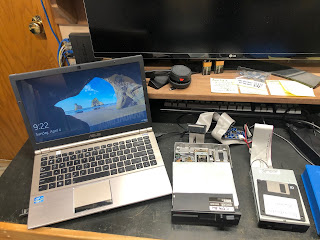Disk Imaging
One of my interests in the Retro Computing hobby has been software preservation. Trying to recover data off some of my wife's old floppy disks from her college days sent me down a path that's gotten me to the point where I own several different Macs and PCs from the 90s that I use as "Bridge Machines" to get data moved off old floppies onto modern hardware.
I'm also interested in a range of different systems and in having the ability to make and restore disks of any format. I became aware of the Kryoflux disk imaging system when reading on Sonic Purity's blog on this article that I've referred to in several bLog articles before. I didn't pursue the Kryoflux because this solution was expensive and because I didn't understand floppy disk technology well enough to be comfortable with flux imaging. Thankfully this knowledge gap can be easily addressed by a great deal of information on the Web, and since then I have put more time into researching this topic.
One of the few benefits of the Pandemic has been that all the Vintage Computer Festivals have been online. I learned about Jim Drew's SuperCard Pro from watching Craig Ernster's presentation. at VCF Midwest 2020. This device is significantly less expensive than Kryoflux. I didn't buy one right away, but when I got my first CP/M machine and didn't know how, or even if I'd be able to make floppy disk copies with the machine I put one on order.
I've paired the SuperCard Pro with the Asus laptop I use as my retro computer engineering PC and set up a couple of floppy drives, both a TEAC 5 1/4" DD drive as well as a newer 3 1/2" 1.44MB floppy drive. I have stored these items together so it doesn't take long to have the disk imaging solution up and running on the bench...
Drive Motor Speed Adjustment



.JPG)
No comments:
Post a Comment